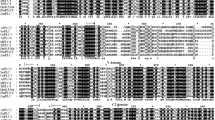Abstract
Phosphoinositide-specific phospholipases C (PLCs) play an important role in many cellular responses and are involved in the production of secondary messengers. We report the cloning and characterization of a cDNA encoding a PLC-delta from Pisum sativum (PsPLC). The amino acid sequence deduced from the cDNA sequence showed 75–80% identity to other plant PLCs and contained the characteristic X, Y and C2 domains. The genomic PLC clone from pea was also characterized and found to contain eight introns. The protein was expressed in Escherichia coli, but the recombinant product did not show any phosphoinositide (PI)- or phosphatidylinositol-4, 5-bisphosphate (PIP2)-specific activity, despite having all known residues required for such activity, and in spite of the fact that its C2 domain was shown to bind calcium. Under similar in vitro assay conditions the recombinant tobacco PLC used as a control showed calcium-dependent PI- and PIP2-specific activity. Though PsPLC did not show enzyme activity in vitro, and may represent an inactive form of PLC, such as those reported in some mammalian systems, analysis of the transcription of PsPLC showed that the gene is expressed in all pea tissues, and is regulated by light in a tissue-specific manner. Roots showed higher expression of PsPLC than shoots. A putative PsPLC promoter region (792 bp) was also cloned and found to contain root-specific and light-responsive cis elements, suggesting that this form of PLC may be involved in important functions in plants.







Similar content being viewed by others
References
Allen V, Swigart P, Cheung R, Cockroft S, Katan M (1997) Regulation of inositol lipid-specific phospholipase Cδ by changes in calcium ion concentration. Biochem J 327:545–552
Assmann SM (2002) Heterotrimeric and unconventional GTP binding proteins in plant signalling. Plant Cell S355-S373
Chomczynski P, Sacchi N (1987) Single-step method of RNA isolation by acid guanidinium thiocyanate-phenol-chloroform extraction. Anal Biochem 162:156–159
Ellis MV, James SR, Perisic O, Downes CP, Williams RL, Katan M (1998) Catalytic domain of phosphoinositide-specific phospholipase C (PLC). J Biol Chem 273:11650–11659
Essen LO, Perisic O, Katan M, Wu Y, Roberts MF, Williams RL (1997a) Structural mapping of the catalytic mechanism for a mammalian phosphoinositide-specific phospholipase C. Biochemistry 36:1704–1718
Essen LO, Perisic O, Lynch DE, Williams RL (1997b) Ternary metal binding site in the C2 domain of phosphoinositide-specific phospholipase C-δ1. Biochemistry 36:2753–2762
Hartweck LM, Llewellyn DJ, Dennis ES (1997) The Arabidopsis thaliana genome has multiple divergent forms of phosphatidylinositol-specific phospholipase C. Gene 202:151–156
Hebsgaard SM, Korning PG, Tolstrup N, Engelbrecht J, Rouze P, Brunak S (1996) Splice site prediction in Arabidopsis thaliana DNA by combining local and global sequence information. Nucleic Acids Res 24:3439–3452
Hirayama T, Ohto C, Mizoguchi T, Shinozaki K (1995) A gene encoding a phosphatidylinositol-specific phospholipase C is induced by dehydration and salt stress in A. thaliana. Proc Natl Acad Sci USA 92:3903–3907
Hoffman HJ, Gromov P, Celis JE (1997) Calcium overlay assay. In: Celis J (ed) Cell biology: a laboratory handbook (vol 4). Academic Press, pp 450–453
Kanematsu T, Misumi Y, Watanabe Y, Ozaki S, Koga T, Iwanaga S, Ikehara Y, Hirata M (1996) A new inositol 1,4,5-trisphosphate binding protein similar to phospholipase Cδ1. Biochem J 313:319–325
Kelley GC, Reks SE, Ondrako JM, Smrcka AV (2001) Phospholipase Cε: a novel Ras effector. EMBO 20:743–745
Kopka J, Pical C, Gray JE, Müller-Röber B (1998a) Molecular and enzymatic characterization of three phosphoinositide-specific phospholipase C isoforms from potato. Plant Physiol 116:239–250
Kopka J, Pical C, Hetherington AM, Müller-Röber B (1998b) Ca2+/phospholipid-binding (C2) domain in multiple plant proteins: novel components of the calcium-sensing apparatus. Plant Mol Biol 36:627–637
Melin PM, Sommarin M, Sandelius AS, Jergil B (1987) Identification of Ca2+- stimulated polyphosphoinositide phospholipase C in isolated plant plasma membranes. FEBS Lett 223:87–91
Melin PM, Pical C, Jergil B, Sommarin M (1992) Polyphosphoinositide phospholipase C in wheat root plasma membranes. Partial purification and characterization. Biochim Biophys Acta 1123:163–169
Otsuki M, Fukami K, Kohno T, Yokota J, Takenawa T (1999) Identification and characterization of a new phospholipase C-like protein, PLC-L2. Biochem Biophys Res Commun 266:97–103
Pical C, Kopka J, Muller-Rober B, Hetherington AM, Gray JE (1997) Isolation of 2 cDNA clones for phosphoinositide-specific phospholipase C from epidermal peels (Accession No. X95877) and guard cells (Accession No. Y11931) of Nicotiana rustica. Plant Physiol 114:748
Reddy MK, Nair S, Tewari KK, Mudgil Y, Yadav BS, Sopory SK (1999) Cloning and characterization of a cDNA encoding topoisomerase II in pea and analysis of its expression in relation to cell proliferation. Plant Mol Biol 41:125–137
Reddy MK, Nair S, Sopory SK (2002) A new approach for efficient directional genome walking using polymerase chain reaction. Anal Biochem 306:154–158
Rhee SG (2001) Regulation of phosphoinositide-specific phospholipase C. Ann Rev Biochem 70:281–312
Shi J, Gonzales RA, Bhattacharyya MK (1995) Characterization of a plasma membrane-associated phosphoinositide-specific phospholipase C from soybean. Plant J 8:381–390
Sopory SK, Deswal R, Chandok MR, Venketaraman G, Goswami M, Munshi M, Reddy MK (2001) Transmembrane signalling in light mediated gene expression role of phospholipids. In: Pardhasaradhi P (ed) Biological processes in living systems. Science Publishers, Enfield, N.H., USA, pp 207–218
Zheng L, Krishnamoorthi R, Zolkoiewski, M, Wang X (2000) Distinct Ca2+-binding properties of novel C2 domains of plant phospholipase D α and β. J Biol Chem 275:19700–19706
Acknowledgements
This research was supported from internal grants from the ICGEB. We are grateful to Dr. M. K. Bhattacharyya (Plant Biology Division at the Samuel Noble Roberts Foundation, Ardmore, Okla.) for providing the soybean PLC cDNA and to Dr. Christophe Pical (Dept. of Plant Biochemistry, Lund University, Sweden) for suggestions regarding the phospholipase C assay
Author information
Authors and Affiliations
Corresponding author
Additional information
Communicated by R. G. Herrmann
Rights and permissions
About this article
Cite this article
Venkataraman, G., Goswami, M., Tuteja, N. et al. Isolation and characterization of a phospholipase C delta isoform from pea that is regulated by light in a tissue specific manner. Mol Genet Genomics 270, 378–386 (2004). https://doi.org/10.1007/s00438-003-0925-0
Received:
Accepted:
Published:
Issue Date:
DOI: https://doi.org/10.1007/s00438-003-0925-0




